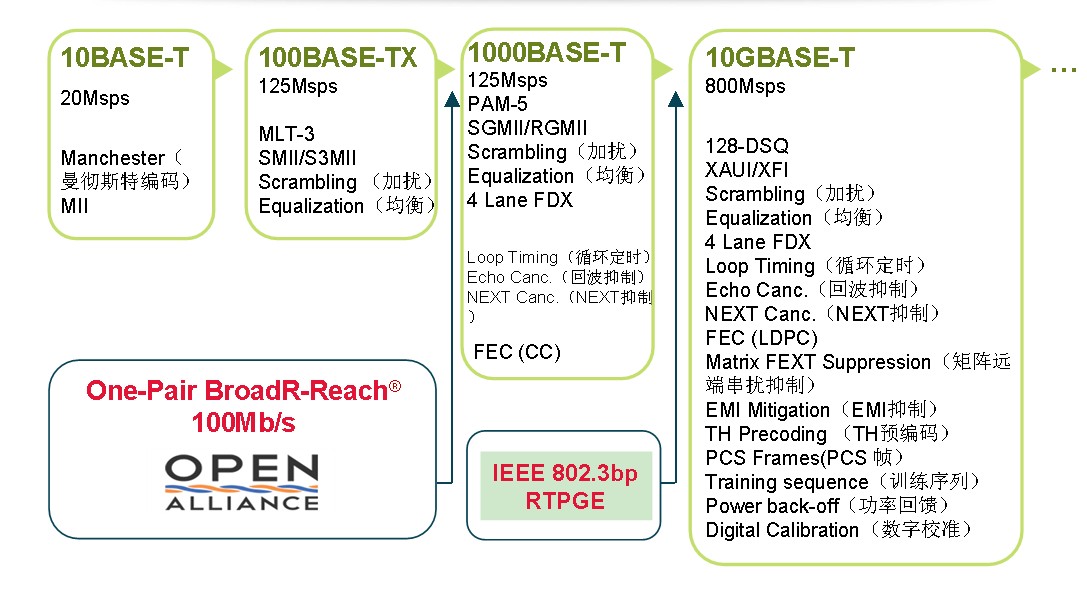Demand for low cost, high transmission rate and high bandwidth network solutions is on the rise due to the significant increase in the number and complexity of in-vehicle electronic devices. Existing automotive communication technologies, such as Media Oriented System Transport (MOST) and Low Voltage Differential Signaling (LVDS), are no longer sufficient to meet these needs because they are not scalable and do not support new services and applications. On the other hand, Ethernet-based communication technology is a cost-effective and scalable solution that supports multiple systems and devices, provides high data rates, and each port has its own bandwidth.
Single twisted pair Ethernet Ethernet uses unshielded twisted pair (UTP) cable for data rates up to 100Mbps. This is a relatively new Ethernet technology that meets the needs of automotive networks for high reliability, low electromagnetic emissions and low power consumption. Using single-pair unshielded cables and smaller and more compact connectors, you can reduce connection costs by up to 80% and wiring weights by up to 30%.
Unlike 100BASE-TX half-duplex technology, single-pair twisted-pair Ethernet Ethernet enables simultaneous transmit and receive (ie, full-duplex) operation on a single twisted pair. For the sake of simplicity, single twisted pair car Ethernet is hereinafter referred to as car Ethernet. Compared to the scramblers used in 100BASE-TX, the car Ethernet digital signal processor (DSP) uses highly optimized scramblers to better separate signals and provide powerful and efficient signals for automotive applications. The scheme is more efficient than the 100BASE-TX system. This makes the signal bandwidth of the car Ethernet limited to 33.3MHz, which is only half of the 100BASE-TX system. The lower signal bandwidth improves return loss, reduces crosstalk, and ensures that the car Ethernet meets automotive electromagnetic emissions standards.

Figure 1 What is BroadR-Reach® Ethernet?
Figure 1 tells us what BroadR-Reach® Ethernet is. For BroadR-Reach® Ethernet, note the following:
(1) BroadR-Reach's physical layer (PHY) has been standardized by the One-Pair Ethernet Alliance (OPEN) to enable bidirectional transmission over a pair of unshielded twisted pair (UTP).
(2) Physical layer of BroadR-Reach vehicle network
Utilizes the mature IEEE standard BASE-T PHYs technology; supports single-pair twisted pair cabling in the vehicle network; has a shorter channel arrival target (15 meters on UTP); is optimized to meet automotive EMC requirements.
(3) Maintaining a standard IEEE MAC interface: Direct support for higher-level Ethernet ecosystems.
Single-pair twisted-pair Ethernet supports the Automotive Cable Diagnostics (ACD) feature, which is critical for high reliability of automotive Ethernet connections. The ACD can detect the fault location of the cable by analyzing the amplitude and delay of the reflected signal. Since the in-vehicle device is battery-powered and does not require high voltage isolation, an AC-coupling capacitor is used at the output instead of a transformer like a standard Ethernet application.
As the demand for in-vehicle networking technology continues to increase, industry leaders are accelerating the standardization of Ethernet platforms by introducing open and widely deployable technologies as early as possible to benefit from cost, performance, availability, and technology integration.
In early November 2011, Broadcom, Freescale, Harman Group and NXP Semiconductors announced the formation of a special interest group (SIG) to promote the large-scale adoption of single-pair unshielded twisted Ethernet Ethernet vehicle connectivity technology. The interest group worked with BMW and Hyundai Motor Co. to develop a single twisted pair open alliance SIG standard to meet the automotive industry's higher requirements for safety, comfort and infotainment, while significantly reducing network complexity and Wiring costs. The popularity of Broadcom's BroadR-Reach® technology has laid the foundation for the new SIG open standards.

Figure 2 Evolution of the Ethernet physical layer (PHY): As the data rate increases, the Ethernet physical layer must adopt more advanced technology to enable high-speed normal transmission of data over unshielded twisted pairs.
PCB LED Module, Lights Source Pcb Modules, Ceiling Led Pbc Modules, Ac Led Linear Module
Shenzhen Isource lighting Co., Ltd , https://www.isourceled.com